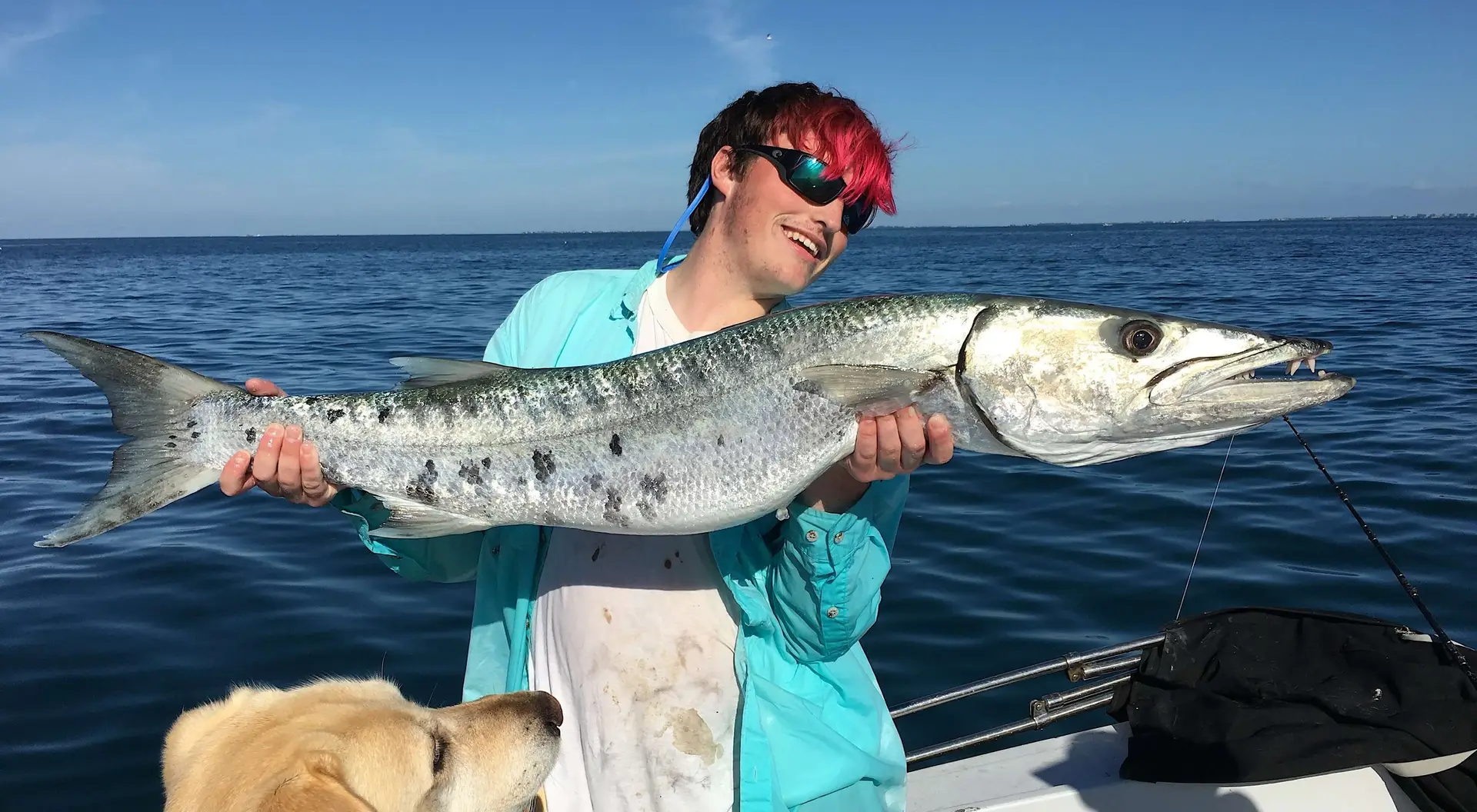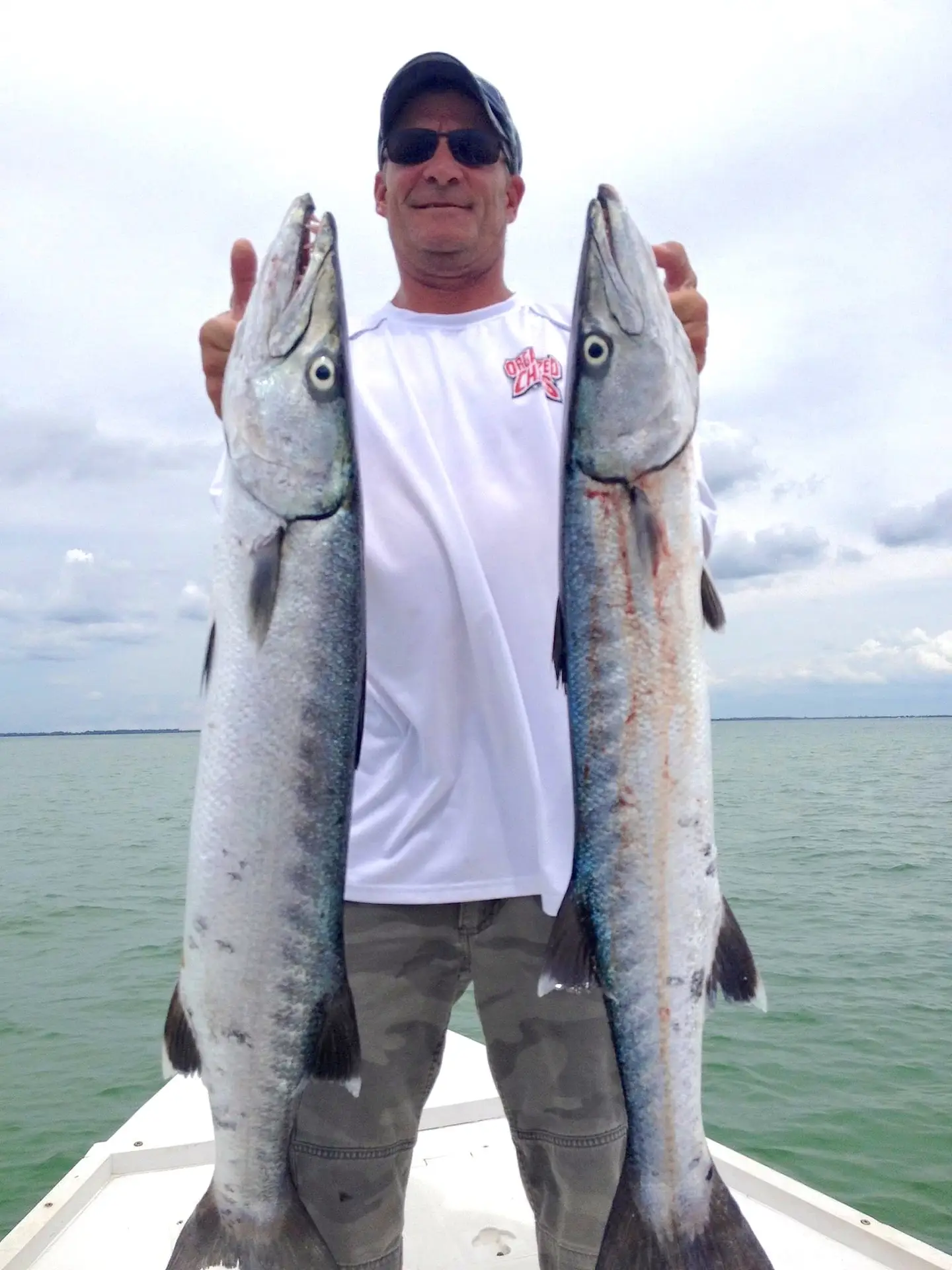

Sanibel Fishing & Captiva Fishing, Barracuda!

Sanibel Fishing & Captiva Fishing, Captiva Island, Friday, April 21: Barracuda; latest Red Tide Report; better water moving north of Sanibel up through Captiva & North Captiva. Please click here to Book A Charter or call 239-472-8658.
We’re located at Castaways Marina, Santiva, Sanibel Island, just before the Blind Pass bridge to Captiva Island.
For more photos and/or fishing reports from our other Captains’ boats from other marinas, please also visit our Sanibel, Fort Myers, Seashell & Shelling, Florida Fishing Report and Cuban Fishing sites. Please check here for Live Sanibel Traffic Cams. Click here for College Of Fishing Hats & Apparel.

“The barracuda is a ray-finned fish known for its large size, fearsome appearance, and ferocious behavior. The barracuda is a saltwater fish of the genus Sphyraena, the only genus in the family Sphyraenidae which was named by Constantine Samuel Rafinesque in 1815.[2] and is found in tropical and subtropical oceans worldwide ranging from the Eastern border of the Atlantic Ocean to the Red Sea and the Caribbean Sea. They are found near the top of the water and near coral reefs and sea grasses.[3]

Barracuda are snake-like in appearance, with prominent, sharp-edged, fang-like teeth, much like piranha, all of different sizes, set in sockets of their large jaws. They have large, pointed heads with an underbite in many species. Their gill covers have no spines and are covered with small scales. Their two dorsal fins are widely separated, with the anterior fin having five spines, and the posterior fin having one spine and 9 soft rays. The posterior dorsal fin is similar in size to the anal fin and is situated above it. The lateral line is prominent and extends straight from head to tail. The spinous dorsal fin is placed above the pelvic fins and is normally retracted in a groove. The caudal fin is moderately forked with its posterior edged double-curved and is set at the end of a stout peduncle. The pectoral fins are placed low on the sides. Its swim bladder is large.

In most cases, a barracuda is dark gray, dark green, white, or blue on its upper body, with silvery sides and a chalky-white belly. Coloration varies somewhat between species. For some species, irregular and unorganized black spots or a row of darker cross-bars occur on each side. Their fins may be yellowish or dusky. Barracudas live primarily in oceans, but certain species, such as the great barracuda, live in brackish water.

Some species grow quite large (up to 165 cm in length),[4] such as Sphyraena sphyraena, found in the Mediterranean Sea and eastern Atlantic; Sphyraena picudilla, ranging on the Atlantic coast of tropical America from North Carolina to Brazil and reaching Bermuda. Other barracuda species are found around the world. Examples are Sphyraena argentea, found from Puget Sound southwards to Cabo San Lucas, Sphyraena jello, from the seas of India and the Malay Peninsula and Archipelago.

Barracudas are ferocious, opportunistic predators, relying on surprise and short bursts of speed, up to 27 mph (43 km/h),[7] to overtake their prey.

Adults of most species are more or less solitary, while young and half-grown fish frequently congregate. Barracudas prey primarily on fish (which may include some as large as themselves). They kill and consume larger prey by tearing chunks of flesh. Barracuda are competitive species and often are seen competing against mackerel, needle fish and sometimes even dolphins for prey.[3]

Barracuda feed on an array of prey including fish such as jacks, grunts, groupers, snappers, small tunas, mullets, killifishes, herrings, and anchovies by simply biting them in half.[8] They also seem to consume smaller species of sustenance that are in front of them.

Like sharks, some species of barracuda are reputed to be dangerous to swimmers. Barracudas are scavengers and may mistake snorkellers for large predators, following them hoping to eat the remains of their prey. Swimmers have reported being bitten by barracuda, but such incidents are rare and possibly caused by poor visibility. Large barracudas can be encountered in muddy shallows on rare occasion. Barracudas may mistake things that glint and shine for prey.[9] One incident reported a barracuda jumping out of the water and injuring a kayaker,[10] but Jason Schratwieser, conservation director of the International Game Fish Association, said that the wound could have been caused by a houndfish.[11]

Hand feeding or touching large barracudas, in general, is to be avoided. Spearfishing around barracudas can also be dangerous, as they are quite capable of ripping a chunk from a wounded fish thrashing on a spear, or out of the arm which is holding the spear. Humans are not on their preferred menu, but haste can lead to confusion.” More background here.
Please click calendar at upper right or call 239-472-8658 to book a charter.
Whether you’re a longtime customer who has fished with us for many years or a first-time customer, expert fisherman or just a family with young children out to catch fish and have fun, you are going to enjoy being out in the boat with Hank and me! We greatly appreciate your friendship and business!
We grew up on Sanibel and Captiva fishing and shelling every day! It is what we know and do well! If you had a good time fishing with Captain Joey Burnsed on a Sanibel & Captiva charter, please post an “excellent” review on Google Places, TripAdvisor, Yelp, or Facebook! If you had any issues at all with your charter, please let us know immediately and we’ll do everything we can to make it right! Huge thanks for doing this!
And you can like us on Facebook.
Fair winds and following seas,
Captain Joey Burnsed ~ please click calendar at the upper left or call 239-472-8658 to book a Sanibel & Captiva Islands, Boca Grande or Fort Myers fishing guide trip or shelling charter.




